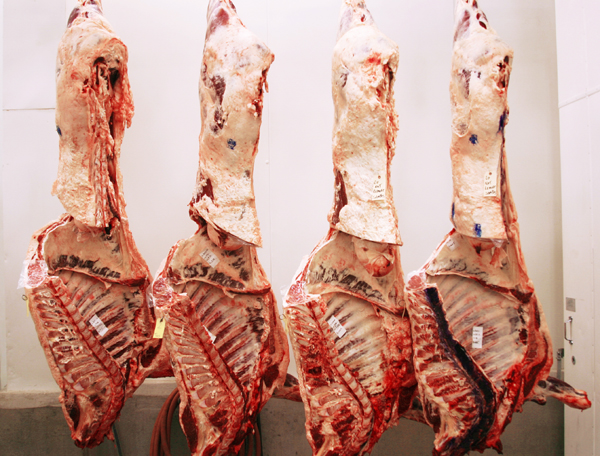
Agricultural News
Beef and Pork Muscle Cuts Lead February Export Advances
Thu, 15 Apr 2010 4:19:41 CDT
 Both U.S. beef and pork exports grew in February, with strong expansion in muscle cuts leading the way in both, according to statistics released by the USDA and compiled by the U.S. Meat Export Federation (USMEF).
Both U.S. beef and pork exports grew in February, with strong expansion in muscle cuts leading the way in both, according to statistics released by the USDA and compiled by the U.S. Meat Export Federation (USMEF).
The monthly value of total U.S. beef exports (muscle cuts and variety meat) jumped 14.5 percent compared to one year ago to reach $252.5 million, while tonnage climbed 8.6 percent to 71,843 metric tons (158.4 million pounds).
Pork exports for the month moved up slightly over one year ago, increasing 2.6 percent in value to $377.6 million and just under 1 percent in volume to 159,331 metric tons (351.3 million pounds).
"There are solid signs of progress in key markets," said Philip Seng, USMEF president and CEO. "And that means positive growth in profitability for U.S. producers."
Pork exports in February accounted for 25 percent of total U.S. pork production, equating to nearly $44 per head, up from $37.37 per head just last month. On the beef side, exports remained steady at 10 percent of production but the value edged up to $123 per head of steer and heifer slaughter from $119 in January.
Beef export markets diversify
Overall beef exports for the first two months of 2010 are up a solid 9 percent in volume to 144,439 metric tons (318.4 million pounds) valued at $500.5 million a 10 percent increase. Importantly, these gains are coming as the United States' No. 1 destination for beef exports, Mexico, continues to suffer from the economic downturn. In January and February, Mexico purchased 39,364 metric tons (86.8 million pounds) of U.S. beef valued at $123.9 million a 23 percent drop in volume and a 31 percent drop in value versus the first two months of 2009.
"We're responding to a greater diversification in the beef markets," said Seng. "We are continuing to focus considerable resources in Mexico on programs that include meat buyer and retailer training, marketing and educational efforts for consumers, and we are confident that this market will rebound as Mexico's economy recovers. Of course, we are simultaneously pursuing opportunities in other markets to help offset this temporary downturn."
Mexico accounted for 38.6 percent of the volume of U.S. beef exports in the first two months of 2009 compared to 27.3 percent so far this year. The Mexican peso spent most of January and February at around 13 pesos to the dollar but the peso has strengthened through March and is now closer to 12 pesos to the dollar, helping to make U.S. beef more affordable.
Despite the fall in exports to Mexico, U.S. beef exports increased in the first two months of 2010 because of markets like:
Canada the No. 2 beef export market is up 19 percent in volume to 21,624 metric tons (47.7 million pounds) for the first two months of the year. Values are up 27 percent to $92.7 million.
Middle East led by Egypt, the Middle East is up 28 percent in volume to 15,267 metric tons (33.7 million pounds) valued at $25.3 million, a 50 percent jump. "The Middle East continues to grow as a top destination for U.S. beef muscle cuts," said Daley, noting that the region imported 5,488 metric tons (12.1 million pounds) valued at $14.9 million, an increase of 162 percent in volume and 79 percent in value.
Japan total beef exports are up 45 percent in volume to 11,660 metric tons (25.7 million pounds) valued at $58.6 million a 35 percent jump. "Even with market access limitations and months of short supply of cattle less than 21 months of age, Japan continues to be a significant growth market," said Daley.
Russia 6,495 metric tons of beef (14.3 million pounds), a 63 percent increase, valued at $11.2 million, a 236 percent spike compared to 2009. Muscle cut exports were 1,270 metric tons, up from just 109 metric tons last year. Daley notes that current data show five consecutive weeks of muscle cut exports exceeding 700 metric tons (1.5 million pounds) per week, with strong exports expected to continue. As further evidence of recovery in Russian demand, Australia's exports to Russia were up 79 percent in the first quarter of 2010.
Taiwan volumes are up 109 percent to 5,750 metric tons (12.7 million pounds) valued at $30.8 million, a 132 percent jump. "The U.S. is dominating Taiwan's high-value beef market, accounting for more than three-quarters of Taiwan's chilled beef imports," said Daley. Imports from the U.S. accounted for 46 percent of Taiwan's total first-quarter beef imports on a value basis, according to Taiwan's import data. USMEF has worked aggressively on the relaunch of U.S. bone-in beef and to reassure consumers of the safety of U.S. beef.
Greater China plus Vietnam the third-largest market for U.S. beef muscle cuts this year, growing 36 percent in volume and 38 percent in value to 15,227 metric tons (33.6 million pounds) valued at $54 million. February exports of 9,082 metric tons (20 million pounds) of muscle cuts alone set a new record, making the region the second-largest volume destination for U.S. beef for the month. Variety meat exports to the region are negligible.
Pork export growth to Mexico continues
Mexico emerged as a solid No. 1 destination for U.S. pork in 2009, and that growth continues in 2010 with a 9 percent hike in volume to 99,768 metric tons (219.9 million pounds) in January and February valued at $173 million a 24 percent jump.
"Pork exports to Mexico helped contribute to the high ham values and high pork cutout values in the first two months of the year," noted Daley. "In January-February, the pork cutout averaged more than $70/cwt, which was about 24 percent higher than last year."
Domestic pork production in Japan continues to rise, affecting imports. According to data by Japan's Agriculture and Livestock Industries Corporation (ALIC), domestic pork production has increased year-on-year each month since March 2009. Marketing of domestic pork in Japan's current fiscal year (data available for April 2009 through January 2010) is up 7 percent while marketing of imported pork is down nearly 14 percent.
U.S. pork muscle cut exports to Japan recovered in February, up 21 percent from January but still off 8.5 percent from last year. For the first two months of 2010, exports were down 17 percent at 59,896 metric tons (132 million pounds) valued at $233.5 million, a decrease of 15 percent. The U.S. continues to dominate in the high-value chilled pork market, earning a 73 percent market share down only 1 percent from last year. Canada and Denmark each gained mainly in frozen market share as the overall U.S. share of total imports slipped from 48 percent last year to 43 percent.
Several other export markets helped the U.S. maintain pork export levels in the first two months of 2010:
Canada exports were up 7 percent in volume to 24,535 metric tons (54.1 million pounds) and 17 percent in value to $84.3 million.
China/Hong Kong this region purchased 15 percent more muscle cuts in the two-month span compared to a year ago, totaling 20,591 metric tons (45.4 million pounds) valued at $34 million, an increase of 32 percent. Hong Kong accounted for 100 percent of the shipments due mainly to the continued H1N1-related Chinese market closure. February exports totaled 14,535 metric tons (32 million pounds) the largest monthly volume of pork muscle cut exports to the region since July 2007. China/Hong Kong also was the No. 2 export market for U.S. pork variety meat behind Mexico, with exports up 14 percent to 25,658 metric tons (56.6 million pounds) valued at $34.4 million, down 4 percent from last year.
The ASEAN region muscle cut exports were double year-ago levels (up 111 percent) to 11,247 metric tons (24.8 million pounds) valued at $22.3 million, an increase of 102 percent. Exports to the Philippines jumped 117 percent to 8,877 metric tons (19.6 million pounds).
South Korea the impact of the Chile-Korea Free Trade Agreement has been felt this year, with two-month muscle cut U.S. exports dipping 37 percent to 10,815 metric tons (23.8 million pounds) valued at $23.6 million, a decrease of 41 percent. According to Korean import data, the decline is much smaller, with imports from the U.S. down 8 percent in the first two months of 2010 while imports from all suppliers were up 4 percent, due mainly to a 65 percent increase in imports from Chile. "Through the Chile-Korea FTA, Chile benefits from duties of less than 10 percent compared to 22 percent to 25 percent (depending on the product) paid by the U.S.," said Daley. "The KORUS FTA would help put the U.S. on track with Chile."
Oceania pork muscle cut exports to this region increased 7 percent to 9,031 metric tons (19.9 million pounds) valued at $19.5 million, which is even with last year. Exports to Australia were up 13 percent to 8,469 metric tons (18.7 million pounds).
Russia pork muscle cuts were down 85 percent to 1,663 metric tons (3.7 million pounds) as the new export protocols were not brought online until March.
Lamb export volume up, value slips
Coming off a record year for the value of U.S. lamb exports in 2009 and the second-highest year for volume exports in the first two months of 2010 are up a solid 37 percent in volume but down 21 percent in value.
Total lamb exports of 2,097 metric tons (4.6 million pounds) are led by Mexico, which has moved from No. 3 to No. 1, accounting for 53.3 percent of U.S. export volume and 52.1 percent of export value. Exports to Mexico are up 204 percent in volume and 243 percent in value.
The leaders for the first two months of 2009 Canada and the Caribbean are down 60 percent and 28 percent in volume and 55 and 79 percent in value, respectively.
Complete Meat Export Numbers for the month are available by clicking here.
WebReadyTM Powered by WireReady® NSI
Top Agricultural News
More Headlines...




















